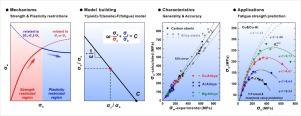Journal of Materials Science & Technology ( IF 11.2 ) Pub Date : 2020-09-08 , DOI: 10.1016/j.jmst.2020.08.037 R. Liu , P. Zhang , Z.J. Zhang , B. Wang , Z.F. Zhang

|
In the first paper, a Y-T-F model was proposed based on the restrictions of both strength and plasticity; the corresponding applications on the fatigue strength prediction have also been discussed. In this second paper, the emphasis will be put on the issues of fatigue strength improvement. Based on the primary form of the Y-T-F model, the parameters are further analyzed and quantified, to clarify the influences of various factors on fatigue strength. Firstly, the damage capacity C is proved to be sensitive to the elastic modulus E, which could change with the alloying components and nano-scaled grain boundaries; the increase of E would lead to the increasing C, thus increase the fatigue strength. Secondly, the microstructure characteristic coefficient a, as well as the yield strength σy and tensile strength σb in the crack initiation region could be influenced by the processing mode, grain size and microstructure uniformity of materials; the change of microstructure characteristics would affect the changing tendency of tensile strength--fatigue strength relation via varying the values of a, σy and σb. Thirdly, the damage weight coefficient ω is found to be a reflection of the fatigue strength declination induced by defects; the defect dimension D, the defect shape correlated stress concentration coefficient Kt, as well as the strengthening level of matrix materials σb are all corresponding factors. Quantified correlations between the above parameters and corresponding factors are comprehensively built up, hence obtaining the influences of either a single factor or multiple factors on fatigue strength. This further developed Y-T-F model would be helpful to clarify the direction of fatigue strength improvement, and contribute to the anti-fatigue design optimization of metallic materials.
中文翻译:

有效的抗疲劳设计和金属材料选择的实用模型:II。参数分析和疲劳强度改善
在第一篇论文中,基于强度和可塑性的限制,提出了一种YTF模型。还讨论了在疲劳强度预测中的相应应用。在第二篇文章中,重点将放在改善疲劳强度上。根据YTF模型的主要形式,对参数进行进一步分析和量化,以弄清各种因素对疲劳强度的影响。首先,证明了损伤能力C对弹性模量E敏感,弹性模量E随合金成分和纳米级晶界的变化而变化。E的增加将导致C的增加,从而增加疲劳强度。其次,微结构特性系数一个,以及屈服强度σ ÿ和抗拉强度σ b在裂纹起始区可以由处理模式,晶粒尺寸和材料的微观结构的均匀性的影响; 通过改变的值疲劳强度关系-的微观结构特性的变化会影响到的拉伸强度的变化趋势一个,σ ÿ和σ b。第三,发现损伤权重系数ω是缺陷引起的疲劳强度偏斜的反映。缺陷尺寸D中,缺陷的形状相关联的应力集中系数的Kt,以及作为基质材料的强化水平σ b是所有相应的因素。全面建立了上述参数与相应因素之间的量化相关性,从而获得了一个或多个因素对疲劳强度的影响。进一步开发的YTF模型将有助于阐明疲劳强度改善的方向,并有助于金属材料的抗疲劳设计优化。











































 京公网安备 11010802027423号
京公网安备 11010802027423号